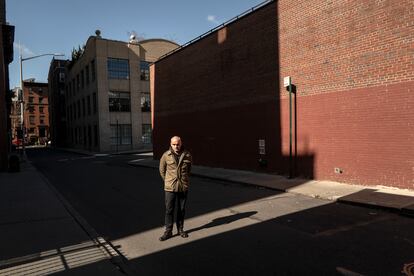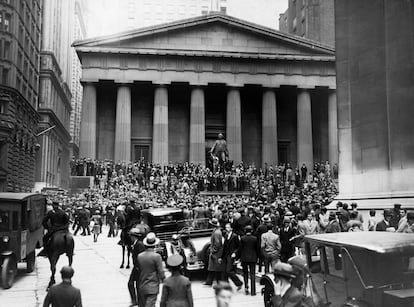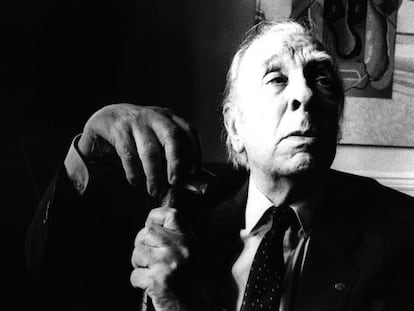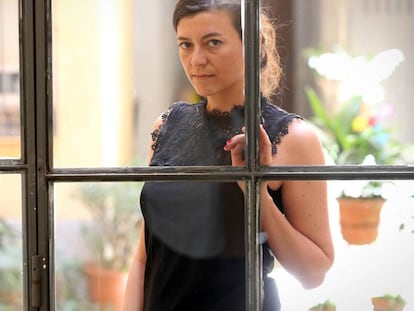The inventor of capitalist realism is an Argentine who writes in English
Hernán Díaz followed up his acclaimed first novel, ‘In the Distance,’ with ‘Trust,’ an ambitious and fragmented look at the machinery that moves Wall Street

Our interview takes place in a secluded café behind the public library in Brooklyn Heights, a New York neighborhood that was once the home of literary giants like Walt Whitman, W. H. Auden, Hart Crane, Truman Capote, Arthur Miller, Paul Bowles and Norman Mailer. Before sitting down, Argentina-born Hernán Díaz affably says, “I prefer to talk about books and literature instead of my own life.” Recognizing the unavoidable, he offers a few brief autobiographical notes. “I was born in a house full of books. In fact, my parents owned a bookstore, so literature was a compelling presence in my life from the beginning. After the 1975 coup, we went into exile in Sweden. I was two years old.” Díaz flashes forward to steer the conversation to a more comfortable subject. “That was where I started writing stories and poems. They were terrible, but I always knew I would dedicate my life to literature... Years later, when democracy returned to Argentina, we were able to go home to Buenos Aires. I studied literature at the university and earned my degree quickly.” Hernán Díaz, who speaks a Spanish vernacular unmistakably rooted in Buenos Aires, is the editor of the prestigious Revista Hispánica Moderna, a century-old Spanish-language academic journal published under the auspices of Columbia University (New York). That vocation makes it all the more surprising that he chose to write in English, his second language. Like Vladimir Nabokov and Joseph Conrad before him, he has a native speaker’s mastery of the language.
“I’ve been living here for 25 years, but that’s not why I write in English,” said Díaz. “It’s the other way around – I’m here because of English. Before coming to New York, I lived in London for two years. I started reading literature in English as a teenager, and that tradition inexplicably appealed to me on an emotional level. I fell in love with the language. It sounds corny, but there is no other way to explain it; the feeling is more important than the reason. To use an analogy from the plastic arts, why does one sculptor choose to work in bronze while others choose marble or wood? Something about the material – its give, malleability, texture, strength and temperature – works differently for each sculptor. I feel the same way about languages.”
His fascination with Anglo-Saxon literature inevitably brings Jorge Luis Borges to mind. My mention of the Argentine master prompts him to say, “I have a profound love for Borges. In fact, my first [non-fiction] book was about him – Borges, Between History and Eternity. It was a play on the title of his book, A History of Eternity.” Despite their prominent places in the Spanish-language literary canon, Borges and Miguel de Cervantes (whom he rereads constantly) are exceptions for Hernán Díaz, who admits to knowing too little about literature written in Spanish. Perhaps this is why Díaz reels off a list of Anglo-Saxon writers when I ask about his favorite authors. “Henry James, George Eliot, Virginia Woolf, Gertrude Stein… and the humorist P.G. Wodehouse. Although he’s a minor author, I like the humor in his novels. Samuel Beckett changed my life, and I think David Markson is the best American writer of the last 30 years, although nobody pays much attention to him anymore. Joy Williams is the most significant living writer in the United States today.”
Hernán Díaz’s extraordinary debut novel In the Distance (2017) is a western that subverts the genre and garnered unanimous acclaim from North American critics who enthusiastically welcomed the author despite his foreign origins. In the Distance was a Pulitzer and PEN/Faulkner award finalist for fiction and raised great expectations for his next endeavor. Five years later, Díaz published his second novel, Trust, which was also warmly received and launched him into the top echelon of American storytellers. The novel’s four parts contain discrete narratives that contradict and complement each other, presenting an insightful and innovative look at Wall Street’s machinery. The book aroused extraordinary interest in literary circles and the world of high finance, which it scrutinized with historical precision. Could Hernán Díaz’s work be called “capitalist realism?”

“The problem lies in defining realism. I prefer a historical rather than a formal definition. Classical 19th-century realism excludes fundamental aspects of our experience of reality. We have the chaotic experience of interiority – what it means to perceive a reality that appears as given and not as something in flux between the subject and objective conditions. In classical realism, reality appears stable and monolithic, but we now know that reality has shattered into fragments. We see ourselves reflected in these shards, so it’s our job to articulate them coherently. To write like Balzac, Stendhal, Dickens or Galdós – authors who fascinate me – would be as absurd as composing music like Beethoven. It’s impossible given our current experience of the world.”
A formal analysis of Hernán Díaz’s book would say it cultivates a realism that offers a compelling study of American society 100 years ago and an in-depth examination of the most turbulent and challenging times in the history of capitalism – the years leading up to the Great Depression of 1929. Trust illuminates persistent themes underlying what is happening today in the society that has been Diaz’s home for 25 years. What made him want to delve so deeply into the heart of capitalism, Wall Street and New York?
“As a system, capitalism is responsible for the shattering of reality I mentioned earlier, a fragmentation that comes from the social division of labor. We do not have a consistent experience of the world because our lives are compartmentalized due to the specialization brought about by the industrial revolution. The shattering of experience and capitalism go hand in hand. When I started writing Trust, I was conscious of the inherent challenges in writing about money because, to paraphrase Whitman, it means so many different things. Every fortune is produced by the alienated labor of multitudes, which is then erased with impunity. I had to think about the multiple facets of money and how to do it justice in my writing.”
“How did you go about it?”
“By creating a proper narrative structure. I knew it had to be layered like tectonic plates to represent the true nature of money, which has a very segmented structure. The book’s protagonist – a composite of several real people – is the richest man in the world. That’s the size of the fortune I wanted to examine. But instead of letting the protagonist write a memoir, I decided to let his secretary – a young woman and the daughter of poor, anarchist Italian immigrants – tell the story. Someone with practically no voice becomes the megaphone for the most powerful person in the world and provides an alternative version of his story. Instead of using exposition, I created a performative story to encourage the reader to perceive the discrepancies between the various voices. The idea is to question the trust we implicitly have in the narratives we read, the enormous ease with which we exempt certain narratives from having a complex relationship with the truth.”
Trust has a range of tones and voices that meld together to establish a relationship of mutual trust (or distrust) between the story and the reader, but also deceive the reader often. It’s a book that exemplifies what it means to write fiction today.
“The novels that interest me most,” said Díaz, “are those that question what a novel is. We participate in a tacit contract with conditions and terms every time we read. Any text establishes that contract, from a medication label to a short story. But our concern about how firmly a short story is anchored in reality is less than in medication labels. I believe this relationship to truth is always present because it is inherent to language and how it relates to the world it describes. With this four-voice structure, in four genres, in four different historical moments, I wanted to make readers question this contract. The first part is written in the realistic tone of the late 19th-century American tradition. It’s a novel-within-a-novel that does something the form no longer allows, which is to pay homage to writers like Edith Wharton and Henry James, and the tone is intentionally a bit decadent. The plot arc of the entire book is presented in the first part, although it’s distorted and equivocal. The second part of the novel is a historical piece aimed at refuting the falsehoods of part one. It’s a juxtaposition of fiction and history, a version of history that the novel challenges. The second part is written in a ‘macho’ tone. Yes, that’s the right word because it’s a very aggressive and abrasive tone. I realized what I was writing would be very hard to read, so I decided to get rid of what I had and figuratively smashed it into a thousand pieces. What remained is a much more interesting fragmentary account than the original, cohesive narrative. The novel’s third part gave me the most trouble because it’s written in a new journalism tone, a la Joan Didion or Lillian Ross. That tone didn’t come naturally to me, so I had to learn to write it. The fourth part responds to the modernist spirit of one of the two women who are the real protagonists of the book and is written as a kind of prose poem.”

Beyond the richness and depth of the characters’ voices, the novel’s real protagonist is money. What led Hernán Díaz to take on this challenge?
“I was surprised to find that in the United States, a country where it has an almost mystical quality, there are really no novels about money. It’s tough to think of any examples. The novels that we directly associate with money are really about class differences. Obviously, the two are intimately related but different. Edith Wharton, Francis Scott Fitzgerald and Bret Easton Ellis (very different writers; some I love, some I loathe) didn’t write about money itself but about the eccentricities of the rich. I was interested in examining the world of high finance without indulging in the fascination with capitalism found in novels like The Great Gatsby. The book aims to be critical; I hope readers will see that. I didn’t want it to be a lavish inventory of the material things we all supposedly covet.”
Sign up for our weekly newsletter to get more English-language news coverage from EL PAÍS USA Edition
Tu suscripción se está usando en otro dispositivo
¿Quieres añadir otro usuario a tu suscripción?
Si continúas leyendo en este dispositivo, no se podrá leer en el otro.
FlechaTu suscripción se está usando en otro dispositivo y solo puedes acceder a EL PAÍS desde un dispositivo a la vez.
Si quieres compartir tu cuenta, cambia tu suscripción a la modalidad Premium, así podrás añadir otro usuario. Cada uno accederá con su propia cuenta de email, lo que os permitirá personalizar vuestra experiencia en EL PAÍS.
¿Tienes una suscripción de empresa? Accede aquí para contratar más cuentas.
En el caso de no saber quién está usando tu cuenta, te recomendamos cambiar tu contraseña aquí.
Si decides continuar compartiendo tu cuenta, este mensaje se mostrará en tu dispositivo y en el de la otra persona que está usando tu cuenta de forma indefinida, afectando a tu experiencia de lectura. Puedes consultar aquí los términos y condiciones de la suscripción digital.
More information
Archived In
Últimas noticias
Most viewed
- Sinaloa Cartel war is taking its toll on Los Chapitos
- Oona Chaplin: ‘I told James Cameron that I was living in a treehouse and starting a permaculture project with a friend’
- Reinhard Genzel, Nobel laureate in physics: ‘One-minute videos will never give you the truth’
- Why the price of coffee has skyrocketed: from Brazilian plantations to specialty coffee houses
- Silver prices are going crazy: This is what’s fueling the rally










































